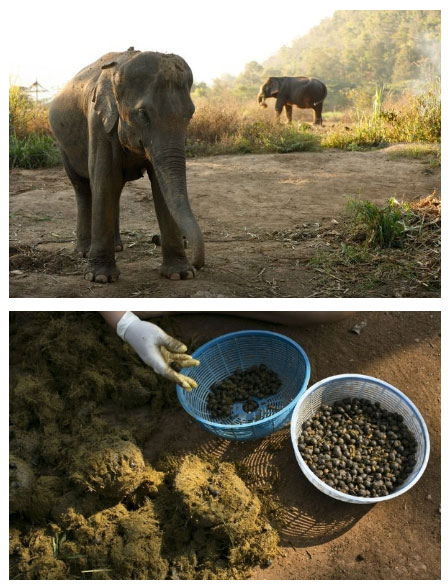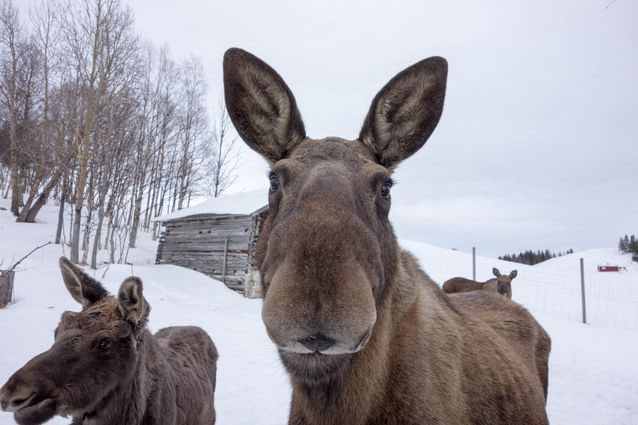'Breaking in' 4 'unbelievable' farms in the world
From the most expensive elephant dung coffee farm in the world, rare and precious deer milk farm, seaweed farming farm to confusing mosquito farms, and "intrusion" to see how interesting and unimaginable it is!
The "most expensive" elephant coffee farm in the world

On the lush hills of the Golden Triangle in northern Thailand, Surin province, special herds of elephants are cared for and "dumped" into one of the world's most expensive and quintessential coffees. , Black Ivory coffee. Elephants are not allowed to eat coffee directly. They eat a natural mixture of bananas, fruits, rice and berries.
When elephants eat coffee beans, the stomach acid breaks down the proteins found in coffee, which makes the bitter taste of coffee. Therefore, the flavor of the coffee is filtered after the elimination process of the excess of elephants will bring the fat flavor without bitter taste like regular coffee. Elephants cannot digest coffee beans. They are spread out with feces.
High-paid workers have to choose clean and roasted coffee beans before being used to make coffee. The fermentation process is said to help coffee flavor become special and only a small amount of this coffee is produced which increases demand and price.
Deer milk farm

Although they mainly live in nature, some deer have been domesticated. Russian farms feed this animal, not for meat, but for their milk. Milk contains more butter than cow's milk. At the same time, it has more beneficial nutrients, including zinc, selenium, iron and powerful enzymes that traditional medicine doctors believe can cure some gastrointestinal problems.
The milky deer only sells domesticated. At a farm in Kostroma, Russia, they are free to graze in the surrounding forests for most of the year. They only produce milk for a short time in the summer when the baby is born. During this time, the elk is milked twice daily and the average daily yield is about half a gallon. Although they are free to walk around, mature adult children are usually domesticated until milk is needed.
Seaweed farm

Seaweed has become a valuable commodity. Seaweed farming has long been a lucrative job in places like Japan, China and Indonesia. However, the use of species such as kelp in other products, such as cosmetics and drugs, and the increasing interest in seaweed as a healthy food has led to an agricultural boom. Where pollution, climate change and overfishing have hurt commercial fishing activities, seaweed culture is a welcome alternative that allows people to continue to earn a living from the great positive.
This aquatic plant is relatively easy to grow if the right species is suitable for the right conditions, without the use of fertilizer or feeding. Due to this completely natural growth, seaweed can be a supplement to other types of aquaculture, such as shellfish or shrimp farming. Some experts are concerned about the explosive changes of seaweed in vulnerable coastal ecosystems, but others welcome this trend as a less invasive way of making money from the oceans.
Mosquito farm

Mosquitoes are one of the most hated insects in the world. They not only ruin a comfortable summer evening, but can also transmit fatal diseases. So why would anyone want to set up a mosquito farm? Through a series of experiments, scientists have discovered that releasing genetically modified mosquitoes into certain areas significantly reduces the population of pathogenic mosquitoes.
For example, such a project involves injecting a particular bacterium into a captive male mosquito. The males are then released and transmit the bacteria to the females they mate. Bacteria inhibit the spread of Zika virus and also disinfect females so that they cannot reproduce. In addition to Zika, this strategy can be used to target diseases such as malaria and dengue.
- Unbelievable breakthroughs in agriculture
- The remarkable vertical farm in the world
- Japan opens the world's first robotic farm
- Japan built the world's largest wind farm
- Video: Explain the sound when breaking the knuckle joint
- Vegetable plant: No need for sun, 95% water saving, high productivity
- Until now, people knew the sound of 'green' when breaking the joints from where
- Germany closed nearly 5,000 farms
- Startled the incredible prohibitions in countries
- The 'incredible' farm uses sun and sea water to produce 17,000 tons of tomatoes a year
- The reason why humans cannot resist viruses has improved a lot
- Install bio-gas powered generators at 42 farms
 'Fine laughs' - Scary and painful torture in ancient times
'Fine laughs' - Scary and painful torture in ancient times The sequence of numbers 142857 of the Egyptian pyramids is known as the strangest number in the world - Why?
The sequence of numbers 142857 of the Egyptian pyramids is known as the strangest number in the world - Why? History of the iron
History of the iron What is alum?
What is alum? Top 6 foods to avoid when drinking coffee
Top 6 foods to avoid when drinking coffee  Benefits of Salt Coffee - A Favorite Drink of Many Young People
Benefits of Salt Coffee - A Favorite Drink of Many Young People  Add These 6 Things to Your Coffee for More Health Benefits
Add These 6 Things to Your Coffee for More Health Benefits  Unexpected link discovered between coffee and liver cancer
Unexpected link discovered between coffee and liver cancer  Coffee grounds make concrete 30% stronger
Coffee grounds make concrete 30% stronger  If you have any disease, you should limit drinking coffee?
If you have any disease, you should limit drinking coffee? 